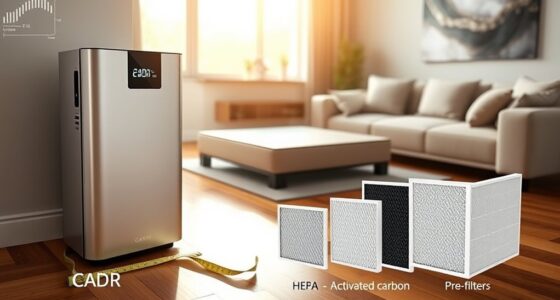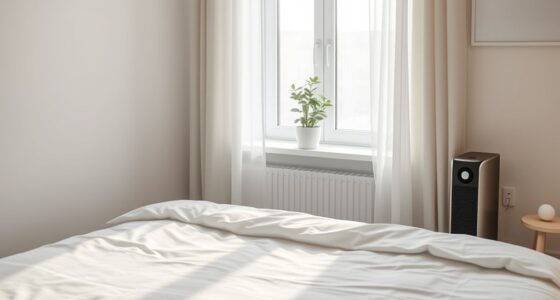For ideal comfort, aim for indoor humidity levels between 40% and 60%. Staying well-hydrated helps your body adapt to humidity changes, supporting temperature regulation and respiratory health. Low humidity can cause dry skin and irritation, while high humidity promotes mold and allergens. Balancing humidity with proper hydration ensures better air quality and temperature control. If you want to find out how to maintain these levels effectively, keep exploring the essential tips that follow.
Key Takeaways
- Maintain indoor humidity levels between 40-60% to optimize comfort and reduce respiratory issues.
- Stay well-hydrated to support temperature regulation and mucous membrane health in fluctuating humidity.
- Use humidifiers or dehumidifiers to control indoor moisture, preventing dry air or excessive dampness.
- Proper hydration enhances the body’s ability to adapt to humidity changes and maintain air quality.
- Regularly monitor environmental conditions and water intake for optimal comfort and respiratory health.

Maintaining proper hydration is essential for your health, especially in environments with varying humidity levels. When humidity fluctuates, it can impact not only how much water your body needs but also the overall air quality around you. Low humidity often leads to dry air, which can cause dehydration faster because your body loses moisture more quickly through your skin and respiratory system. Conversely, high humidity can make it feel hotter than it actually is and can contribute to discomfort and issues like mold growth, which further affects air quality. Staying well-hydrated helps your body adapt to these changing conditions, ensuring that your internal systems function efficiently.
One of the key roles hydration plays is in temperature regulation. Your body releases sweat to cool down when you’re overheated, but if the air is overly dry or humid, this process becomes less efficient. In dry environments, sweat evaporates rapidly, which can cause dehydration before you even realize it. On the other hand, in humid conditions, sweat struggles to evaporate, trapping heat and making it harder for your body to cool itself. This imbalance can lead to overheating, fatigue, or heat exhaustion. Proper hydration supports your body’s ability to maintain a stable internal temperature, regardless of external conditions. Drinking enough water ensures your sweat mechanism works smoothly, helping you stay comfortable and safe whether you’re indoors or outdoors.
Air quality is directly linked to humidity levels and hydration. Dry air tends to irritate your respiratory passages, leading to coughing, sore throat, or breathing difficulties. Dehydration worsens these symptoms because your mucous membranes dry out, reducing their ability to trap dust, pollutants, and pathogens. Maintaining good hydration keeps your mucous membranes moist and resilient, improving your air quality and making it easier to breathe. In humid environments, excess moisture can promote mold, dust mites, and other allergens, which can further compromise air quality. Additionally, proper ventilation plays a vital role in maintaining a healthy indoor environment. Drinking enough water helps your body manage these fluctuations more effectively, supporting your respiratory health.
Ultimately, understanding the relationship between hydration, air quality, and temperature regulation can help you stay comfortable and healthy. Monitoring your water intake and being mindful of the humidity levels around you allows you to adapt your habits accordingly. Use humidifiers or dehumidifiers as needed to maintain an ideal indoor environment, and drink water regularly, especially during hot or dry days. By doing so, you’ll support your body’s natural processes, improve air quality, and maintain a stable internal temperature, making every environment more comfortable and safer for your well-being.
Frequently Asked Questions
How Does Humidity Affect Indoor Air Quality?
Humidity directly impacts indoor air quality by influencing airborne allergens and mold growth. When humidity levels are too high, you create a perfect environment for mold and dust mites, which can worsen allergies. Conversely, low humidity can dry out your airways and increase airborne allergens like pet dander. Maintaining ideal humidity helps keep these allergens in check and prevents mold from thriving, ensuring a healthier indoor environment for you.
Can Low Humidity Cause Skin Issues?
Yes, low humidity can cause skin issues like dryness and eczema flare-ups. When the air’s too dry, your skin loses moisture, leading to irritation and increased sensitivity. You might notice your skin feeling rough, cracked, or itchy more often. To prevent this, maintain balanced humidity levels and use moisturizers regularly. Keeping your indoor environment properly humidified helps protect your skin and reduces discomfort from dryness and flare-ups.
What Are Signs of Dehydration From Humidity?
You might notice humidity symptoms like dry skin, chapped lips, or a sore throat, which are dehydration indicators. Feeling unusually tired, dizzy, or experiencing headaches can also signal dehydration from low humidity. If your eyes feel gritty or you have dark urine, these are additional signs you’re not staying properly hydrated. Keep an eye out for these symptoms to address dehydration early and stay comfortable.
How Do Different Climates Impact Hydration Needs?
Think of climate as the tailor of your hydration needs, adjusting the fit of your strategies. In hot, dry climates, you’ll sweat more and need to drink water frequently, while humid environments cause you to lose fluids through sweat and evaporation. To adapt, modify your hydration strategies accordingly—drink more water, include electrolytes, and wear breathable clothing. By understanding your climate, you guarantee your body stays balanced and comfortable.
Is It Better to Use a Humidifier or Dehumidifier?
It’s better to use a humidifier or dehumidifier based on your environment. A humidifier benefits you by adding moisture if your air is too dry, easing breathing and skin issues, but dehumidifier drawbacks include over-drying the air and causing discomfort. If your space feels damp, a dehumidifier helps prevent mold and musty odors. Choose the device that aligns with your humidity needs for ideal comfort.
Conclusion
Just as a well-tuned instrument finds harmony in its environment, maintaining proper hydration and humidity levels guarantees your comfort and well-being. Remember, balance is key—too little moisture leaves you parched, too much can weigh you down. Like a gentle breeze guiding a sailboat, aligning these elements helps you navigate daily life smoothly. Stay mindful of your body’s needs, and you’ll find serenity in the simple art of harmony, much like nature’s own perfect rhythm.








